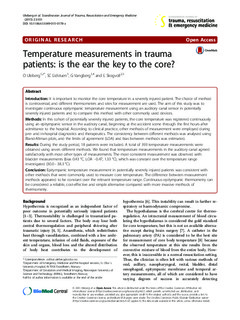Temperature measurements in trauma patients: is the ear the key to the core?
Peer reviewed, Journal article
Permanent lenke
http://hdl.handle.net/11250/2381925Utgivelsesdato
2015Metadata
Vis full innførselSamlinger
Originalversjon
Scandinavian Journal of Trauma, Resuscitation and Emergency Medicine 2015, 23:101 10.1186/s13049-015-0178-zSammendrag
Introduction: It is important to monitor the core temperature in a severely injured patient. The choice of method
is controversial, and different thermometers and sites for measurement are used. The aim of this study was to
investigate continuous epitympanic temperature measurement using an auditory canal sensor in potentially
severely injured patients and to compare this method with other commonly used devices.
Methods:In this cohort of potentially severely injured patients, the core temperature was registered continuously
using an epitympanic sensor in the auditory canal, beginning at the accident scene through the first hours after
admittance to the hospital. According to clinical practice, other methods of measurement were employed during
pre- and in-hospital diagnostics and therapeutics. The consistency between different methods was analysed using
Bland-Altman plots, and the limits of agreement (LOA) and bias between methods was estimated.
Results:During the study period, 18 patients were included. A total of 393 temperature measurements were
obtained using seven different methods. We found that temperature measurements in the auditory canal agreed
satisfactorily with most other types of measurements. The most consistent measurement was observed with
bladder measurements (bias 0.43 °C, LOA−0.47, 1.33 °C), which was constant over the temperature range
investigated (30.0 - 38.3 °C).
Conclusion:Epitympanic temperature measurement in potentially severely injured patients was consistent with
other methods that were commonly used to measure core temperature. The difference between measurement
methods appeared to be constant over the relevant temperature range. Continuous epitympanic thermometry can
be considered a reliable, cost-effective and simple alternative compared with more invasive methods of
thermometry.
